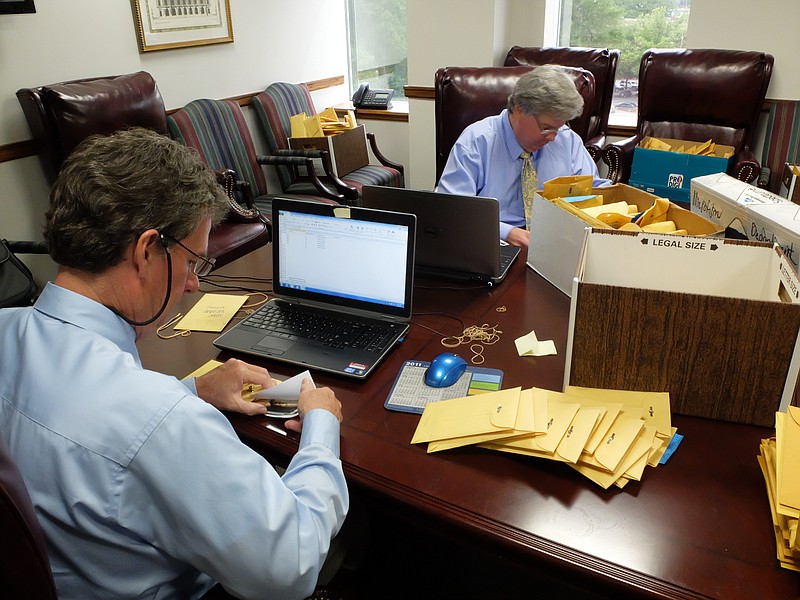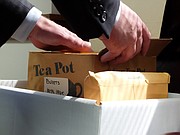If there's one case in there impacted by this, then it's worth it.
Down Seventh Street in Chattanooga, near the Hamilton County Courthouse, on the eighth floor of the Newell Tower, around the corner and inside a conference room, underneath a surveillance system, and surrounded by file cabinets, microfilm and envelopes, a team of auditors sits at a table.
The six-person group has reported there since April 21 - at 2:18 p.m., to be exact - after a prosecutor accompanied a vehicle full of evidence. The entire ride was documented on videotape by the Hamilton County Sheriff's Office.
In this room, everyone must sign in and out. At least two cameras peer down from the plaster ceiling. And a handful of people have keys to the room, which is roughly the size of a storage unit.
Why?
To ensure integrity of the evidence.
It's been an important talking point since Dec. 8, when District Attorney General Neal Pinkston announced that a significant amount of unprocessed evidence had turned up in the medical examiner's office. An employee there discovered boxes brimming with autopsy envelopes that contained fingernail clippings, hair follicles and sometimes DNA cards.
Beginning in late summer, the employee attempted to inventory everything by hand. Then a member of the Cold Case Unit visited the office and saw the boxes, spokeswoman Melydia Clewell said Tuesday. He called Pinkston immediately, and Pinkston in turn met with three Hamilton County Criminal Court judges to share what he knew at the time.
The evidence pertained to at least 35 homicides, accidental deaths and suicides between 1986 and 2002. His office didn't yet understand the full amount or value of the evidence. But he wanted to find out, because it could exonerate some people. Since then, Clewell said, the auditors have received another 11 boxes from the sheriff's microfilm department, widening the scope of their inventory.
For transparency, Pinkston assembled an independent citizens committee of prosecutors, judges, professors and defense attorneys. They created a protocol to match each autopsy to its case, and to later gauge its use. Could it exonerate someone? Could it support reopening a case in which evidence was collected but never tested? Or was it moot because police decided not to charge somebody?
So far, much remains unknown - hence the audit, Clewell said.
In the conference room Tuesday, she pointed to six boxes against a wall, yellow envelopes sticking out.
"Each of these envelopes represents an autopsy," she said. And upwards of 500 contained more than just photos of the victim.
She then motioned to a silver file cabinet the size of a dresser.
"They've been through three of these file cabinets in the last week," she said of the auditors, who chuckled when asked to estimate how many files were inside.
The current task is matching each autopsy envelope to its corresponding case files. But that's easier said than done. For example, each autopsy has an identification number. But incident reports generated by law enforcement agencies often have a different one. The same goes for docket numbers in General Sessions Court, Clewell said.
"But if there's one case in there impacted by this, then it's worth it," she said.
In the meantime, Chattanooga's legal community is left to speculate about the process, which is scheduled to conclude by the end of the year.
"The evidence could have bolstered the state's case. It could have been used to negotiate a more severe plea bargain. But it also could have exonerated somebody," said defense attorney Bill Speek. "This stuff needs to be looked at. It's just fundamentally fair."
And it's crucial, throughout the process, to ensure integrity as evidence passes hands. Especially if any of that unprocessed evidence reopens a case or goes back to trial, said Hugh Moore, a committee member and attorney at the Chambliss, Bahner & Stophel P.C. law firm.
"You don't want to have any sort of gap for the jury," Moore said. "You want to be able to say, 'this pack of money, this bullet, this box of meth, whatever it was, was found on x-date by this officer, and he put his initials here and he signed off on it and he handed it to this officer.'"
The Hamilton County Medical Examiner's Office declined to comment for this article. But that silence doesn't indicate fault, one expert said.
"What I would suggest to you is they've done their jobs," said David Fowler, 2016 president of the National Association of Medical Examiners. "I think they've been entirely appropriate and, if anybody ever wanted the material, it's there. Either to exonerate or prosecute, that material is there for future analysis."
Beneath all the unprocessed evidence is a careful relationship among law enforcement, medical examiners and prosecutors.
Lee Davis, a former prosecutor, current defense attorney and member of the citizens committee, laid it out: When a homicide or major crime occurs, a law enforcement agency responds and remains in charge of that crime from investigation until charges are filed. Then, the district attorney picks up control of the case.
"The evidence at all times is under care and custody and control at the police department," Davis said. "If a detective has a case, then some of it goes to the medical examiner's office, it is the detective's responsibility to keep up with that evidence."
The catch is, a detective may never press charges.
As Fowler noted: "The [detective] may have, for instance, just found somebody dead at home. And, in anticipation, there were fingernails, swabs, put in the files. And then, at some point, police never found a perpetrator, or found no crime was committed, and didn't come and get it."
The Chattanooga Police Department could not be reached for comment. Hamilton County Sheriff's Office spokesman Matt Lea said he could not comment until the district attorney's office finished its inventory process.
Davis said he wasn't surprised an employee found evidence in the medical examiner's office.
"If it's a suicide or unknown cause of death there's usually no charge. But it should be noted in the medical examiner's file or [by] the law enforcement agency about why stuff was left there.
"And not that it wasn't done at the time," he added. "But it hasn't been kept linked up or current. I think what this shows is, a little bit of evidence that's left behind in a given year accumulates and becomes quite a bit."
Contact staff writer Zack Peterson at zpeterson@timesfreepress.com or 423-757-6347 with story ideas or tips. Follow @zackpeterson918.

